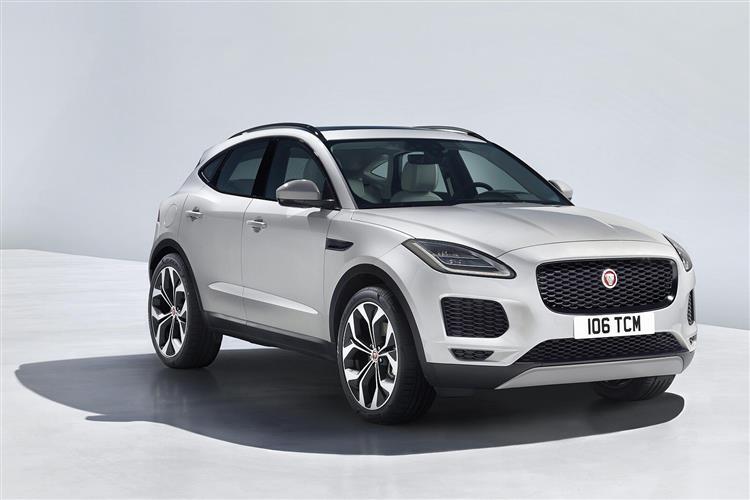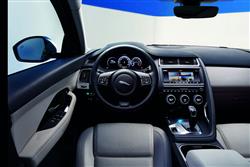How will you view?
This is a sample, showing 30 seconds of each section.
PACE ACE? (some text hidden) SECTIONED_new_jaguarepace_2018
By Jonathan Crouch
Introductionword count: 47
Launched in 2017, Jaguar's E-PACE gave buyers another, very interesting option in the growing segment for premium-badged compact SUVs. It was a crucial car for the company - but does it make sense as a used buy? There was certainly a lot riding on this little crossover.
Modelsword count: 8
5dr SUV (2.0, 3.0 Diesel, 2.0, 3.0 Petrol)
Historyword count: 332
Did you ever think, a couple of decades back, that Jaguar would become a brand with sales based mainly around SUVs? It is today. In 2016, the company's mid-sized F-PACE model introduced the crossover community to the concept of a Jag, but it's this smaller E-PACE, announced a year later, that's these days is this manufacturer's best seller. The name suggests an electric connection - misleadingly as it turns out. Jaguar has another SUV - the battery-powered I-PACE - to provide that. Both are cars the company decided it needed but found it didn't have the capacity to build. Hence the need for an agreement with Magna Steyr in Austria, who've been making G-Class models for Mercedes since 1979 and from launch built many of the E-PACE variants destined for our market. From 2018, production was shared with Jaguar's joint venture plant at Changshu in China. The car targets the premium part of the SUV 'C'-segment, the compact part of the crossover market aimed at people who need something Qashqai or Ateca-sized but want a posher badge on the bonnet. The JLR business already has a car competing here - the Range Rover Evoque - and in order to simplify the design process, based the E-PACE on most of the same engineering used in that model. From launch, shared mechanicals included the 9-speed auto gearbox and haldex 4WD system used in most variants of this Jaguar, plus Ingenium four cylinder diesel power and a hefty steel chassis that, rather confusingly, made this car heavier than its larger but aluminium-orientated F-PACE showroom stablemate. What potential buyers will care more about though, is the idea of Jaguar sports car design and dynamics being available in a five seat compact performance SUV. That's an enticing prospect and it explains why over 80% of E-PACE prospects were customers new to the brand. The E-PACE sold in this form until 2020, when it was substantially updated. It's the earlier 2017-2020-era models though, that we look at here.
What You Getword count: 463
Where rival brands merely shrink larger models to create more compact SUVs, Jaguar opted to create something quite different with the E-PACE. This, according to the Coventry company, was 'the sportscar of its class'. It certainly had much more of a purposeful look than most of its rivals, thanks to what the designers claimed was inspiration borrowed from their F-TYPE sportscar. That isn't particularly evident at first glance, but if you know that car and then look a little closer at this one, you'll begin to pick up F-TYPE cues in the headlights, the muscular rear haunches and the teardrop graphic of the rear side windows. And up-front? Well if you didn't pick up the visual F-TYPE sports car references outside, you may more readily notice them once seated in the so-called 'Sports Command' driving position. As in the F-PACE, Jaguar provided the slightly raised seating stance that SUV buyers like, while still allowing you to feel an involved component in the driving experience. The three-spoke steering wheel is F-TYPE-derived too, as are the analogue instrument binnacle dials that most models provide beyond it. Plusher variants were fitted out with the 12.3-inch virtual instrument display that we first saw on Jaguar's XJ saloon. Anything the instrument binnacle area can't tell you will of course be covered off by the centre-dash screen. From launch, E-PACE buyers got as standard the larger 10-inch 'Touch Pro' monitor that F-PACE buyers in this period had to pay extra for. This monitor's your access point not only to the expected audio, climate, telephone and navigation functions but also to in-car wi-fi and a whole suite of 'InControl' connected-car technologies, including an 'InControl Apps' feature that allows you to select from a whole series of downloadable compatible applications. When it's time to take a seat in the rear, the swept-back roof line suggests that headroom in the back might be at something of a premium, but in the event, rear seat head room is actually quite good, even if your E-PACE features the optional panoramic glass roof. That lets in some much-needed light, as do the neat little rear C-pillar mini-windows. The boot is accessed on plusher models via a powered tailgate. From new, this could be specified to rise with a wave of your foot beneath the bumper if you approach the car, key-in-pocket, laden down with bags. The hatch rises to reveal one of the largest luggage compartments in the compact SUV segment, offering a 577-litre capacity that can easily swallow a folded buggy, a full set of golf clubs sideways or six flight suitcases. Under the floor, there's a further 93-litre compartment, though you only get that if you get a car whose original owner chose not to pay extra for a space saver spare wheel.
To see the full road test text contact us on 0330 0020 227
Pictures (high res disabled)

.jpg)
|
.jpg)
|
.jpg)
| |||
.jpg)
|
.jpg)
|
.jpg)
| |||
.jpg)
|
.jpg)
|
.jpg)
| |||
.jpg)
|
.jpg)
|
.jpg)
| |||

|
Scoring (subset of scores)
Category: Crossover or SUV 4x4s
| Performance | |
| Handling | |
| Comfort | |
| Space | |
| Styling, Build, Value, Equipment, Depreciation, Handling, Insurance and Total scores are available with our full data feed. | |



